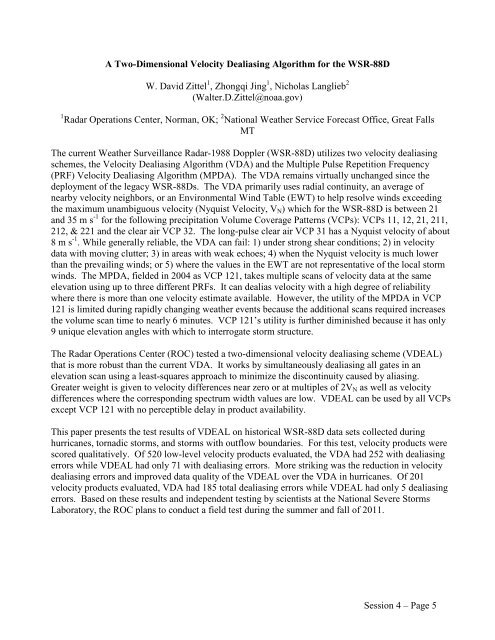65th IHC Booklet/Program (pdf - 4.9MB) - Office of the Federal ...
65th IHC Booklet/Program (pdf - 4.9MB) - Office of the Federal ...
65th IHC Booklet/Program (pdf - 4.9MB) - Office of the Federal ...
Create successful ePaper yourself
Turn your PDF publications into a flip-book with our unique Google optimized e-Paper software.
A Two-Dimensional Velocity Dealiasing Algorithm for <strong>the</strong> WSR-88D<br />
W. David Zittel 1 , Zhongqi Jing 1 , Nicholas Langlieb 2<br />
(Walter.D.Zittel@noaa.gov)<br />
1 Radar Operations Center, Norman, OK; 2 National Wea<strong>the</strong>r Service Forecast <strong>Office</strong>, Great Falls<br />
MT<br />
The current Wea<strong>the</strong>r Surveillance Radar-1988 Doppler (WSR-88D) utilizes two velocity dealiasing<br />
schemes, <strong>the</strong> Velocity Dealiasing Algorithm (VDA) and <strong>the</strong> Multiple Pulse Repetition Frequency<br />
(PRF) Velocity Dealiasing Algorithm (MPDA). The VDA remains virtually unchanged since <strong>the</strong><br />
deployment <strong>of</strong> <strong>the</strong> legacy WSR-88Ds. The VDA primarily uses radial continuity, an average <strong>of</strong><br />
nearby velocity neighbors, or an Environmental Wind Table (EWT) to help resolve winds exceeding<br />
<strong>the</strong> maximum unambiguous velocity (Nyquist Velocity, V N ) which for <strong>the</strong> WSR-88D is between 21<br />
and 35 m s -1 for <strong>the</strong> following precipitation Volume Coverage Patterns (VCPs): VCPs 11, 12, 21, 211,<br />
212, & 221 and <strong>the</strong> clear air VCP 32. The long-pulse clear air VCP 31 has a Nyquist velocity <strong>of</strong> about<br />
8 m s -1 . While generally reliable, <strong>the</strong> VDA can fail: 1) under strong shear conditions; 2) in velocity<br />
data with moving clutter; 3) in areas with weak echoes; 4) when <strong>the</strong> Nyquist velocity is much lower<br />
than <strong>the</strong> prevailing winds; or 5) where <strong>the</strong> values in <strong>the</strong> EWT are not representative <strong>of</strong> <strong>the</strong> local storm<br />
winds. The MPDA, fielded in 2004 as VCP 121, takes multiple scans <strong>of</strong> velocity data at <strong>the</strong> same<br />
elevation using up to three different PRFs. It can dealias velocity with a high degree <strong>of</strong> reliability<br />
where <strong>the</strong>re is more than one velocity estimate available. However, <strong>the</strong> utility <strong>of</strong> <strong>the</strong> MPDA in VCP<br />
121 is limited during rapidly changing wea<strong>the</strong>r events because <strong>the</strong> additional scans required increases<br />
<strong>the</strong> volume scan time to nearly 6 minutes. VCP 121’s utility is fur<strong>the</strong>r diminished because it has only<br />
9 unique elevation angles with which to interrogate storm structure.<br />
The Radar Operations Center (ROC) tested a two-dimensional velocity dealiasing scheme (VDEAL)<br />
that is more robust than <strong>the</strong> current VDA. It works by simultaneously dealiasing all gates in an<br />
elevation scan using a least-squares approach to minimize <strong>the</strong> discontinuity caused by aliasing.<br />
Greater weight is given to velocity differences near zero or at multiples <strong>of</strong> 2V N as well as velocity<br />
differences where <strong>the</strong> corresponding spectrum width values are low. VDEAL can be used by all VCPs<br />
except VCP 121 with no perceptible delay in product availability.<br />
This paper presents <strong>the</strong> test results <strong>of</strong> VDEAL on historical WSR-88D data sets collected during<br />
hurricanes, tornadic storms, and storms with outflow boundaries. For this test, velocity products were<br />
scored qualitatively. Of 520 low-level velocity products evaluated, <strong>the</strong> VDA had 252 with dealiasing<br />
errors while VDEAL had only 71 with dealiasing errors. More striking was <strong>the</strong> reduction in velocity<br />
dealiasing errors and improved data quality <strong>of</strong> <strong>the</strong> VDEAL over <strong>the</strong> VDA in hurricanes. Of 201<br />
velocity products evaluated, VDA had 185 total dealiasing errors while VDEAL had only 5 dealiasing<br />
errors. Based on <strong>the</strong>se results and independent testing by scientists at <strong>the</strong> National Severe Storms<br />
Laboratory, <strong>the</strong> ROC plans to conduct a field test during <strong>the</strong> summer and fall <strong>of</strong> 2011.<br />
Session 4 – Page 5
















